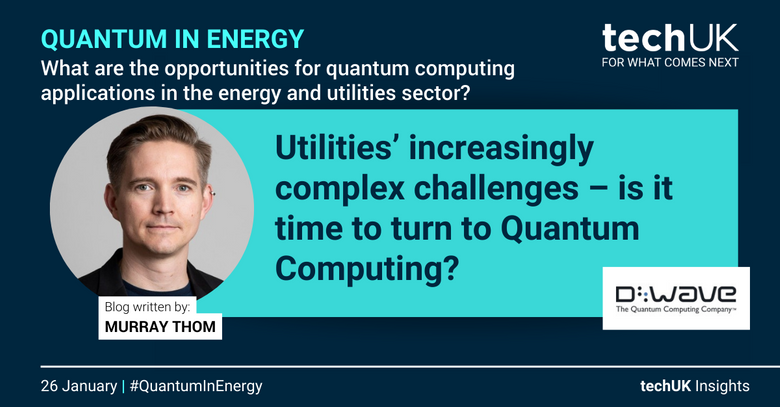Utilities’ Increasingly Complex Challenges – Is It Time to Turn to Quantum Computing? (Guest blog by D-Wave)

The Changing Energy Environment
Global weather patterns are shifting, causing increased complexity for utilities to manage. From heat waves to bone-chilling cold snaps, the intensity and frequency of these weather fluctuations make it more difficult than ever to predict and support utility needs of customers. The impact of climate instability and the increase in energy needs mean that the energy sector is undergoing rapid changes to address these new challenges.

With continued weather pattern fluctuations across the globe, the energy industry must think creatively and use emerging technologies to ensure it is able to serve community needs. Quantum computing is primed to assist utilities as they tackle some of the toughest challenges facing the industry, according to McKinsey & Company. Understanding quantum’s applications and how it can support reliable energy grids could be a game changer for the industry. With quantum computing available in the cloud combined with powerful quantum-hybrid applications, utilities can now build applications using the power of quantum plus classical computation to solve problems that have been outside the reach of traditional computation methods.
A report from the Quantum Economic Development Consortium (QED-C) highlighted a variety of use cases that U.S. electric sector organizations identified where today’s quantum computing applications have the most feasibility and potential impact. Energy Market Optimization was ranked to have the greatest feasibility and the highest impact over the other ideas, but the report also noted other key use cases including fault prediction, integrated planning and optimization for grid reliability and resilience.
Growing Global Concerns for a Reliable and Resilient Energy Grid
Reliability of energy grids is a global problem. In the United States, the Texas grid failed due to outdated infrastructure and extreme weather conditions. Dry summers in Norway have led to reduced hydropower and a consideration to limit electricity exports. Droughts are also happening in Italy, where it’s drier than at any time since 1800, and in the U.K., the extreme heat that turned lush fields to straw has led power grid operators to hire more workers amid fears of electricity shortages.
The U.K. grid incorporates a variety of different energy resources, but the majority comes from gas, wind and nuclear. As the U.K. continues to implement the Net Zero Strategy to reduce emissions and decarbonize all sectors of the U.K. economy, the pressure on utilities to use renewable resources increases.
The benefits of a diversified energy resource mix are undeniable, but there are numerous challenges that arise when integrating renewable generation sources, updating outdated infrastructure, and modeling changes in customer energy usage complicated by the importance of efficient optimization to secure grid resilience. An additional layer of complexity is being added with the push toward electric vehicles (EVs) which must be plugged into the already taxed grid. During the summer of 2022, drivers in California were asked not to charge in their EVs due to grid stress caused by the extreme heat. Because wind and solar are more variable and decentralized sources of energy, this can also lead to larger financial and logistical integration challenges as their share of the resource mix increases. These ever-changing factors, exacerbated by extreme weather fluctuations, are complicating the already difficult challenges of scheduling energy generation resources in the most economic and reliable methods possible. Together, these optimization problems are among the most important problems facing the industry today.
These problems are also among the most complex. And this is an entry point for quantum computing and quantum-hybrid applications. With millions of variables (from weather to scheduling the right type of resource at the right time), these challenges can be highly complex given there are interactions within the problems that complicate the path to a solution. Each variable affects the millions of other variables in different ways, decreasing the ability to determine good or in some cases, even usable, outcomes. Utility companies have the opportunity to strive for precision, optimization and resilience in their grids. Quantum computing – and specifically annealing quantum computing - is emerging as a potential solution for grid reliability, given the speed and accuracy at which it can handle a high number of variables and problem constraints.
The Future of the Grid Incorporates Quantum
As mathematical challenges increase and data-driven decisions become central to utility decision-making, emerging analytics and computing technologies, such as quantum computing, will be instrumental for the energy industry. Quantum-hybrid applications, which incorporate the best solutions from quantum computing and high-performance computing, allow utilities to unlock more computational power to address the growing optimization problems. But not all quantum systems have the same capabilities.
Quantum annealing systems are native optimization engines and therefore are uniquely suited to tackle many of these growing use cases: from grid optimization and planning to forecasting and grid security. Quantum computing could be pivotal for better understanding distribution on the grid and the complex mathematical challenges that arise in the transmission and distribution systems. Quantum-hybrid applications could also be used for weather modeling to provide better customer use predictions head of weather fluctuations. Moreover, as utilities deploy additional technology, such as sensors, greater computational power will be needed to ensure useful and timely decision making harnessing the increased influx of data.
Forward thinking utilities and regulators are beginning to explore how today’s quantum computing technology can be integrated with classical computation to provide the best of both worlds to solve of the most challenging problems.
Quantum’s Role in Energy Systems Optimization
According to E.ON, one of Europe’s largest electric utility service providers, technology can modernize an outdated grid to effectively integrate intermittent renewable generation sources. E.ON’s R&D team has used quantum computing solutions developed by D-Wave to optimize the detection of communities in the electrical grid in order to efficiently manage electricity contributions. The benefit of community detection? Energy production and consumption can be locally managed, ensuring stability and flexibility in the grid, allowing for stronger reliance on renewable generation sources.
In this scenario, the quantum computer and the hybrid solvers were able to efficiently arrive at a robust grid-partitioning solution, while the classical computing approach continued to grapple unsuccessfully with the problem. “This potential speedup would help to plan and operate electrical grids in real-time,” noted the E.ON team, adding that it should be feasible to actively tune the clustering process to accommodate changes in prosumer activity in the overall grid.
Impact of Distributed Energy Resources
Distributed energy resources (DERs) are also increasing grid complexity, requiring novel solutions to better manage contribution, efficiency and integration. New energy sources such as those from bidirectional electric vehicle (EV) charging, rooftop solar panels and battery storage are among the contributors sending energy back to the grid, which could help lower costs and provide further resiliency. More EVs, in particular, are starting to engage in bidirectional charging; meaning that not only does the EV draw power from the grid, but it could act to supply grids or homes with electricity. These diverse energy resources introduce new complexities in terms of resource integration and management, another area where quantum computing is primed to help navigate these multi-constraint challenges.
Quantum’s Necessity in Sustainable Energy
As global sustainability efforts continue, many of the problems facing utilities are complex optimization problems, and many of these are use-cases that can be unlocked by annealing quantum computing. As utilities adapt, modernize and deploy updated infrastructure, they must embrace new technology solutions – like quantum computing – in order to drive more optimal grid management and maximize reliable energy output.
Get involved with our work
All of techUK’s work is led by our members – keep in touch or get involved with our work on transport and infrastructure by joining our groups.





